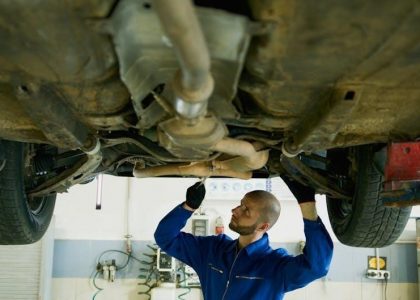A manual dock leveler is a device used in warehouses and distribution centers to bridge the gap between the dock and a truck or trailer, ensuring smooth loading/unloading operations.
1.1 Definition and Purpose
A manual dock leveler is a mechanical device designed to create a smooth transition between a loading dock and a vehicle, enabling efficient and safe loading/unloading operations. Its primary purpose is to bridge height differences, ensuring easy movement of goods and equipment. This cost-effective solution reduces physical strain on workers and minimizes potential damage to cargo. It is widely used in warehouses, distribution centers, and manufacturing facilities to streamline logistics processes.
1.2 Brief History and Evolution
The manual dock leveler emerged in the mid-20th century as industrialization demanded efficient loading solutions. Early versions were basic, relying on manual adjustment to bridge height differences. Over time, advancements introduced spring-based systems and hinges for smoother operation. By the 1980s, hydraulic and mechanical designs became standard, enhancing safety and functionality. Today, manual dock levelers remain a cornerstone of warehouse operations, continually evolving to meet modern logistics demands and industry standards.

Key Features of a Manual Dock Leveler
A manual dock leveler features a sturdy deck, hinged lips, and a simple yet durable mechanism for raising and lowering, ensuring safe and efficient loading operations.
2.1 Main Components
The main components of a manual dock leveler include the deck, the hinged lip, and the spring or counterbalance system. The deck is the main platform that spans the gap between the dock and the vehicle. The hinged lip extends and retracts to align with the vehicle’s bed. The spring or counterbalance mechanism provides the necessary force for raising and lowering the deck, ensuring smooth and controlled movement during operations.
2.2 Operation Mechanism
The manual dock leveler operates through a combination of mechanical components. Users push or pull the deck to raise or lower it, utilizing a counterbalance system for effortless movement. The hinged lip extends or retracts manually to align with the vehicle bed, ensuring a smooth transition. This mechanism allows for precise height adjustment and secure positioning, facilitating safe and efficient loading or unloading operations.
2.3 Safety Features
Manual dock levelers incorporate essential safety features, including a counterbalance system to prevent sudden movements and a secure locking mechanism to maintain the deck’s position. Anti-slip surfaces reduce the risk of accidents, while barriers and visual indicators ensure safe operation. These features are designed to protect personnel and equipment during loading and unloading processes, ensuring a secure working environment.

How to Operate a Manual Dock Leveler
Operating a manual dock leveler involves raising the deck, aligning it with the truck bed, extending the lip for a secure connection, and ensuring safety throughout the process.
3.1 Raising the Deck
Raising the deck of a manual dock leveler begins by ensuring the area is clear of obstacles. Pull the release handle to disengage the locking mechanism, then use the hinge to lift the deck slowly and evenly. Continue until the deck reaches the desired height, ensuring it aligns properly with the truck bed for safe and efficient loading or unloading operations. Always maintain control during this process to prevent accidents.
3.2 Lowering the Deck
Lowering the deck of a manual dock leveler requires careful attention to ensure safety and proper alignment. Begin by checking the surrounding area for obstructions or personnel. Slowly release the handle to allow the deck to descend gradually. Ensure the deck aligns with the truck bed or ground level as it lowers. Once fully lowered, secure the deck in place to maintain stability and prevent unintended movement during loading or unloading operations.
3.3 Engaging and Disengaging the Lip
To engage the lip, align the dock leveler with the truck bed and pull the release handle to lower the lip gently onto the truck. Ensure it is securely locked in place to prevent movement during loading/unloading. Disengaging involves releasing the lock, lifting the lip, and retracting it back onto the deck. Always follow safety guidelines to avoid accidents and ensure smooth operations.
Benefits of Using a Manual Dock Leveler
A manual dock leveler offers cost-effectiveness, energy efficiency, and reliability, making it a practical solution for smooth loading/unloading operations in various industrial settings.
4.1 Cost-Effectiveness
Manual dock levelers are a budget-friendly option for warehouses, offering significant savings on initial purchase and maintenance compared to powered alternatives. With minimal mechanical components, they reduce energy consumption and operational costs. Their simplicity ensures lower repair expenses, making them a financially smart choice for businesses seeking efficient, affordable solutions for their loading dock needs.
4.2 Energy Efficiency
Manual dock levelers are highly energy-efficient as they operate without electricity, eliminating the need for power consumption during use. This reduces energy costs and environmental impact. Their mechanical design ensures minimal energy expenditure, making them an eco-friendly option for warehouses. By relying on manual operation, they conserve resources and lower overall energy demands, contributing to a more sustainable loading dock solution.
4.3 Reliability and Durability
Manual dock levelers are known for their robust construction and long-lasting performance. Built with durable materials, they withstand heavy use and harsh environments. Their simple mechanical design minimizes moving parts, reducing the risk of breakdowns. Regular maintenance ensures optimal functionality, making them a dependable choice for high-traffic loading docks. Their reliability and durability contribute to consistent performance over time, providing a cost-effective solution for warehouses and distribution centers.

Maintenance and Repair
Regular maintenance is crucial for extending the life of a manual dock leveler. Inspections, lubrication, and cleaning ensure smooth operation. Addressing worn parts promptly prevents major repairs.
5.1 Regular Inspection Checklist
A thorough inspection of the manual dock leveler should include checking the deck alignment, lip condition, spring tension, and frame for any damage or wear. Lubricate hinges and pivot points to ensure smooth movement. Additionally, verify that all safety mechanisms are functioning correctly and that there are no obstructions hindering proper operation. Regular checks help prevent unexpected breakdowns and ensure safe usage.
5.2 Lubrication and Cleaning
Regular lubrication of moving parts, such as hinges and springs, ensures smooth operation and prevents corrosion. Use high-quality grease suitable for industrial applications. Clean debris and dirt from the deck and lip regularly to maintain functionality. Remove any obstructions that could interfere with the leveler’s movement. Proper lubrication and cleaning extend the lifespan of the dock leveler and ensure safe, efficient performance during loading and unloading operations.
5.3 Common Repairs and Solutions
Common repairs for manual dock levelers include addressing misalignment issues, replacing worn-out springs, and repairing damaged lip hinges. Tightening loose bolts and ensuring proper spring tension can resolve uneven deck movement. For severe damage, such as bent frames or broken parts, professional welding or part replacement may be necessary. Always refer to the manufacturer’s manual for specific repair guidelines and consult a professional if unsure.

Safety Considerations
Ensure proper training, regular inspections, and emergency preparedness to mitigate risks. Always follow manufacturer guidelines and maintain equipment to prevent accidents during operation.
6.1 Potential Hazards
Manual dock levelers pose risks such as equipment malfunction, improper alignment, or operator error. Hazards include unexpected deck movement, lip failure, or uneven surfaces, which can cause accidents or injuries. Ensure proper training and regular maintenance to minimize these risks and maintain a safe working environment.
6.2 Safety Best Practices
Always ensure the dock leveler is properly secured and aligned before use. Conduct regular inspections to check for wear and tear. Train operators to follow manufacturer guidelines and use personal protective equipment. Clear the area of obstacles and ensure proper lighting to enhance visibility. Never exceed the weight capacity, and always engage safety locks when the leveler is not in use to prevent accidental movement.
6.3 Emergency Procedures
In case of a manual dock leveler malfunction, immediately stop operations and evacuate the area. Contact trained personnel or the manufacturer for assistance. If someone is injured, provide first aid and call emergency services. Keep emergency exits clear and ensure all safety protocols are followed to prevent further incidents. Regular training on emergency procedures is crucial for swift and effective responses.

Applications and Industries
Manual dock levelers are essential in warehouses, distribution centers, and manufacturing facilities for efficient loading/unloading. They cater to specific industry requirements, ensuring safe material handling.
7.1 Warehouses and Distribution Centers
Manual dock levelers are widely used in warehouses and distribution centers to facilitate efficient loading and unloading of goods. Their versatility and ease of operation make them ideal for bridging the gap between the dock and various vehicle types. By enabling smooth transitions, they enhance workflow efficiency and safety, making them an essential component in modern logistics and supply chain operations.
7.2 Manufacturing Facilities
Manual dock levelers are essential in manufacturing facilities where efficient material handling is critical. They provide a safe and reliable way to load and unload heavy machinery or raw materials from trucks. Their durability and ease of use make them ideal for high-volume production environments, ensuring seamless operations and minimizing downtime. This equipment is particularly valued in industries requiring precise alignment and consistent performance.
7.3 Specific Industry Requirements
Manual dock levelers must meet specific demands based on industry needs. For example, food processing requires hygienic designs, while cold storage needs insulated or heated options. Heavy-duty manufacturing may demand higher load capacities, while retail settings might prioritize ease of use. Customization options, such as specialized coatings or sizes, ensure the leveler aligns with unique operational demands, enhancing efficiency and safety across diverse industrial environments.
Choosing the Right Manual Dock Leveler
Selecting the ideal manual dock leveler involves considering load capacity, industry-specific needs, and installation compatibility to ensure optimal performance and safety for your operations.
8.1 Understanding Load Capacity
Load capacity is crucial when selecting a manual dock leveler. It refers to the maximum weight the equipment can safely handle. Determining the right capacity ensures efficient operations and prevents damage. Consider the weight of goods and equipment that will be loaded or unloaded. Exceeding the capacity can lead to mechanical failure, compromising safety and productivity. Always choose a leveler with a capacity that exceeds your typical loads to accommodate unexpected weight variations. Proper assessment of load capacity extends the lifespan of the dock leveler and ensures reliable performance over time.
8.2 Industry-Specific Needs
Manual dock levelers must be tailored to meet the unique demands of different industries. For instance, food and beverage facilities may require hygienic, corrosion-resistant surfaces, while cold storage warehouses need insulated or climate-controlled solutions. Manufacturing plants might prioritize heavy-duty models to handle machinery, whereas retail distribution centers may focus on versatility for varying truck sizes. Understanding industry-specific requirements ensures the leveler aligns with operational needs, enhancing efficiency and safety. Customization options are key to meeting these diverse demands effectively.
8.3 Installation and Compatibility
Proper installation of a manual dock leveler ensures optimal performance and safety. The leveler must be compatible with the dock’s structural design and weight capacity. Compatibility with existing infrastructure, such as dock height and trailer bed dimensions, is crucial. Professional installation is recommended to guarantee alignment and stability, minimizing risks during loading/unloading operations. Compatibility also extends to integrating with other dock equipment, ensuring seamless workflow efficiency in various industrial settings.
Troubleshooting Common Issues
Common issues include deck malfunction, lip alignment problems, and uneven leveling. Regular inspections and maintenance can often resolve these problems, ensuring smooth operation and safety.
9.1 Deck Not Raising or Lowering
If the deck fails to raise or lower, check for obstructions, worn-out springs, or hinge misalignment. Ensure the manual activation mechanism is functioning properly. Lubricate moving parts if stuck. Inspect the frame for damage or rust, which may hinder movement. If issues persist, consult a professional technician to repair or replace faulty components, ensuring safe and efficient operation.
9.2 Lip Not Extending or Retracting
If the lip fails to extend or retract, inspect for mechanical obstructions, damaged hinges, or worn-out springs. Ensure proper engagement of the release mechanism. Check for debris or rust in the lip’s pivot points. Lubricate all moving parts to eliminate friction. If the issue persists, examine the lip’s alignment and adjust or replace faulty components to restore smooth operation and ensure safety during loading/unloading processes.
9.3 Uneven Alignment
Uneven alignment occurs when the dock leveler doesn’t properly align with the truck bed, causing safety risks and operational inefficiencies. Check for worn-out or damaged hinges, springs, or support frames. Ensure the dock is level and the leveler is correctly installed. Adjust the leveling feet or replace faulty components to restore even alignment. Regular maintenance and inspections can prevent misalignment issues, ensuring smooth and safe loading/unloading operations.

Future Trends in Dock Leveler Technology
The future of manual dock levelers lies in automation, smart technology integration, and energy-efficient designs. Expect advanced real-time monitoring systems and seamless integration with warehouse management systems for optimal efficiency.
10.1 Automation and Smart Technology
Automation and smart technology are revolutionizing manual dock levelers by integrating sensors, real-time monitoring, and automated adjustments. These advancements enable precise alignment, enhanced safety, and energy efficiency. Smart systems can detect potential issues before they occur, reducing downtime. Additionally, integration with warehouse management systems allows for seamless operations and data-driven decision-making, ensuring optimal performance in modern logistics environments. This trend is expected to streamline loading/unloading processes significantly.
10.2 Sustainable and Eco-Friendly Designs
Sustainable and eco-friendly designs are becoming a priority in manual dock leveler technology. Manufacturers are incorporating recycled materials and energy-efficient components to reduce environmental impact. These designs focus on minimizing waste and lowering carbon footprints. Additionally, eco-friendly coatings and corrosion-resistant treatments extend product lifespan, reducing the need for frequent replacements. Such innovations align with global sustainability goals, making manual dock levelers more environmentally responsible while maintaining performance and durability.
10.3 Integration with Warehouse Management Systems
Manual dock levelers are increasingly being integrated with warehouse management systems (WMS) to enhance operational efficiency. This integration allows for real-time monitoring and automation of loading operations, optimizing dock scheduling and resource allocation. By enabling seamless communication between the dock leveler and the WMS, facilities can streamline workflows, reduce errors, and improve overall logistics management. This advanced connectivity supports data-driven decision-making and enhances the synchronization of warehouse activities.





